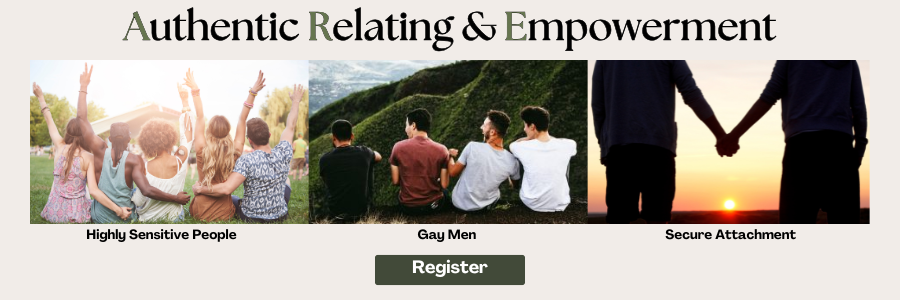I remember being a young boy before I knew I was HSP and always feeling different from other people. I always thought there was something wrong with me. At an early age, I began to feel terrified of showing people who I truly was out of fear of being judged and rejected.
Due to my sensory processing sensitivity (SPS), I did all sorts of quirky and unusual things. My nervous system felt overstimulated most of the time, and I developed tics as a way of coping with the overstimulation. My nervous system always felt strung out and anxious, and I never knew why because I didn’t know I had SPS. It took me 34 years of living with SPS before I realized I was HSP. Learning about my trait has made life so much easier because I now know how to accommodate my sensitivity.
The reason I shared this story is to let you into my world so I can show you how the lone wolf showed up in my life, and maybe you can relate.
My way of coping with feeling different was to deny my authentic self. I kept it hidden from the world so I didn’t have to face what I feared most – people rejecting me for being “weird.” I remember having tons of friends growing up, but I always felt alone on the inside because I never felt connected to who I authentically was.
As I got older, I began to live more authentically, but the fear of rejection was still really intense for me. This is when I became a lone wolf and started isolating myself from people as a way to feel safe. I didn’t quite know how to be my authentic self in the presence of others yet.
There is a lot of psychology to unpack around all this and I want to spend the rest of this blog sharing my own psychological insights and how I have learned to cope with my fear of rejection and learn how to belong.

Let’s dig into the psychology…
Many HSPs tend to have core wounds around belonging due to the shame of feeling different and being misunderstood or even shamed in childhood for being sensitive.
We may have been told we are too shy, needy, emotional, dramatic, sensitive, feminine, etc. To put it simply, we were rejected, neglected, or abandoned for being who we authentically were.
Not having these core needs for belonging and acceptance met in childhood can lead to attachment trauma. Attachment trauma is essentially a trauma that is caused by disconnection from an attachment figure which greatly impairs our ability to feel secure in who we are. It is the attachment to our caregiver in our early years that allows us to feel safe to develop and embrace our authentic selves.
The unhealed attachment trauma throughout life can lead to many relational challenges and an inability to feel safe and trusting in our adult relationships.
When attachment trauma goes unhealed, it can lead to 2 common trauma responses: hyper-independence and social isolation. This can lead to the lone wolf syndrome, where HSPs consciously choose extreme introversion because of the intense fear of rejection, neglect, or abandonment. Most of us are essentially terrified of recreating our past of unmet needs and rejection that we become a lone wolf and push away all connection. For many HSPs, it feels easier to be a lone wolf than it does to risk being rejected.
There is a secret to all this when it comes to healing the lone wolf syndrome. Before I share the secret, I want to mention that there is a beneficial side to being a lone wolf. It can be a healthy quality to be independent and be comfortable spending time alone. After all, many HSPs find being around people too often can be overstimulating and intense because we feel the energy of others so deeply.

The secret to healing the lone wolf syndrome
Many HSPs, even after healing their intense fear of rejection, still prefer to spend time alone. And btw, not all HSPs are introverts. Studies show that 30% of HSPs are extroverts, leaving 70% of us introverts. This debunks the myth that sensitivity is just a byproduct of introversion – it’s not, and there is now clear data that they are two separate traits.
However, there is also a shadow side to the lone wolf, and this is what I want to explore so we can stop being crippled by the fear of rejection and begin the healing process. The secret to healing the lone wolf syndrome is to learn to stop rejecting yourself.
When HSPs stop rejecting themselves, they will stop feeling crippled by the rejection from the world around them. The rejection from the world around us mirrors our self-rejection, and it’s being used to help us heal by pointing out to us the parts of us we have yet to learn to love.
When we become confident in our sensitivity, it doesn’t matter what the people around us feel about it because we have learned to own who we are and no longer need to hide ourselves out of shame.
It is important for the HSP to know that attachment trauma was created in a relational dynamic and, therefore, it must be healed in a relational dynamic. This is often a tough pill to swallow for many of us because the very thing we need to do to heal is the very thing we are terrified of – quite the catch-22, eh?
Let me soften the blow a bit because I know how scared I was when I first started moving into the community to do my relational and attachment healing work. This work is best done with other HSPs. It is within these like-hearted connections that we feel seen and heard for who we authentically are. When people get us, we feel less like aliens, have ease in being ourselves, and have the acceptance and belonging that comes with that – this is healing!
This is why many HSPs feel so happy when they meet other HSPs; they don’t feel alone anymore and realize that connection can actually feel safe with people who understand their traits.
You deserve all the yummy connections in the world, and you deserve to feel safe as well. Once you start making peace with yourself (loving all the aspects of who you are) and learn to be more kind to yourself, you will start to feel safe to show up more authentically with others.

Allow yourself to have connection
Connection feels good, and you deserve to feel good!
While the lone wolf has its advantages and likely kept you safe for many years, it can lead to overwhelming loneliness. Let the lone wolf join the pack once in a while so you can heal the attachment trauma and set yourself free to belong. You don’t want life to pass you by and miss out on beautiful connections and experiences. Those are the regrets we have on our deathbed. We realize that rejection isn’t all that bad, and we wish we didn’t let fear dictate how we lived our lives.
Most times, it’s worth risking rejection for a meaningful connection, and it usually pays off in the end.
It’s so worth it, and so are you!
Lift your cheekbones,
Matt




